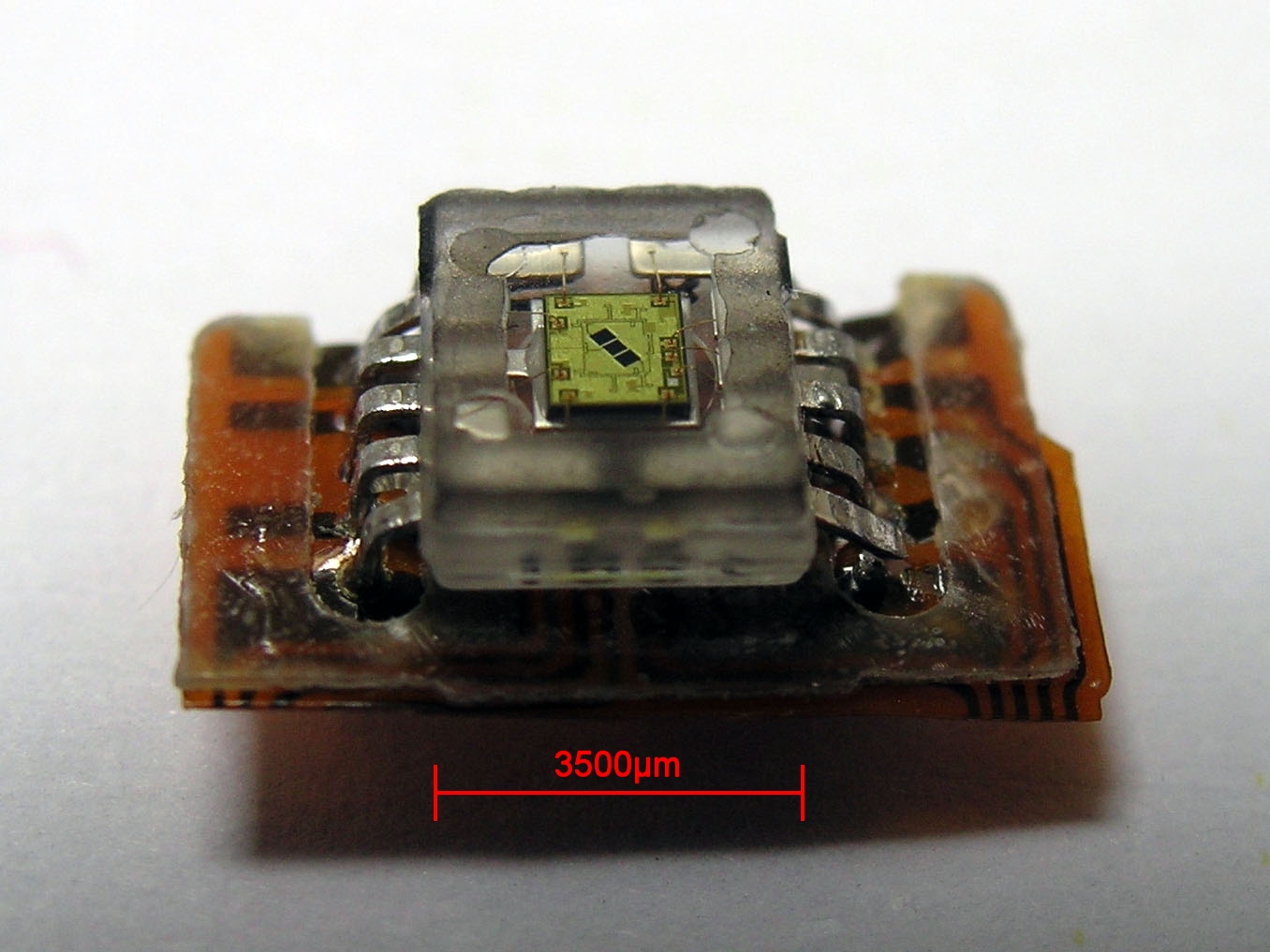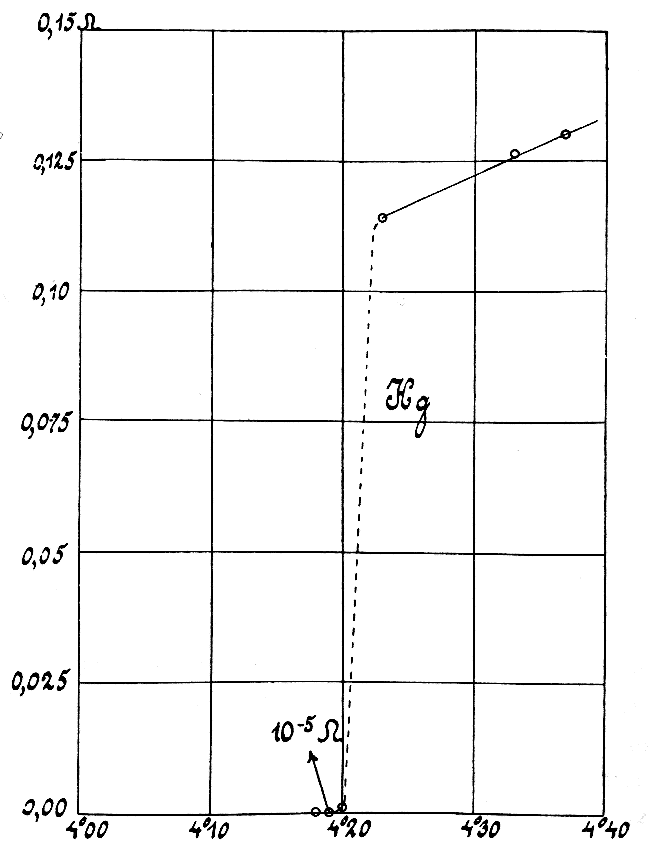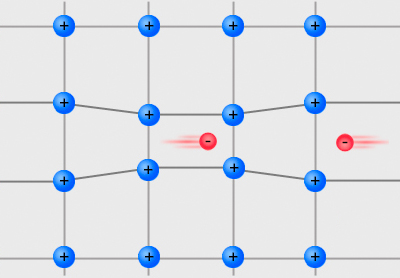|
Kinetic Inductance
Kinetic inductance is the manifestation of the inertial mass of mobile charge carriers in alternating electric fields as an equivalent series inductance. Kinetic inductance is observed in high carrier mobility conductors (e.g. superconductors) and at very high frequencies. Explanation A change in electromotive force (emf) will be opposed by the inertia of the charge carriers since, like all objects with mass, they prefer to be traveling at constant velocity and therefore it takes a finite time to accelerate the particle. This is similar to how a change in emf is opposed by the finite rate of change of magnetic flux in an inductor. The resulting phase lag in voltage is identical for both energy storage mechanisms, making them indistinguishable in a normal circuit. Kinetic inductance (L_) arises naturally in the Drude model of electrical conduction considering not only the DC conductivity but also the finite relaxation time (collision time) \tau of the mobile charge carriers w ... [...More Info...] [...Related Items...] OR: [Wikipedia] [Google] [Baidu] |
Charge Carriers
In solid state physics, a charge carrier is a particle or quasiparticle that is free to move, carrying an electric charge, especially the particles that carry electric charges in electrical conductors. Examples are electrons, ions and holes. In a conducting medium, an electric field can exert force on these free particles, causing a net motion of the particles through the medium; this is what constitutes an electric current. The electron and the proton are the elementary charge carriers, each carrying one elementary charge (''e''), of the same magnitude and opposite sign. In conductors In conducting mediums, particles serve to carry charge. In many metals, the charge carriers are electrons. One or two of the valence electrons from each atom are able to move about freely within the crystal structure of the metal. The free electrons are referred to as conduction electrons, and the cloud of free electrons is called a Fermi gas. Many metals have electron and hole bands. In som ... [...More Info...] [...Related Items...] OR: [Wikipedia] [Google] [Baidu] |
Photodetector
Photodetectors, also called photosensors, are devices that detect light or other forms of electromagnetic radiation and convert it into an electrical signal. They are essential in a wide range of applications, from digital imaging and optical communication to scientific research and industrial automation. Photodetectors can be classified by their mechanism of detection, such as the photoelectric effect, photochemical reactions, or thermal effects, or by performance metrics like spectral response. Common types include photodiodes, phototransistors, and photomultiplier tubes, each suited to specific uses. Solar cells, which convert light into electricity, are also a type of photodetector. This article explores the principles behind photodetectors, their various types, applications, and recent advancements in the field. History The development of photodetectors began with the discovery of the photoelectric effect by Heinrich Hertz in 1887, later explained by Albert Einst ... [...More Info...] [...Related Items...] OR: [Wikipedia] [Google] [Baidu] |
Superconductivity
Superconductivity is a set of physical properties observed in superconductors: materials where Electrical resistance and conductance, electrical resistance vanishes and Magnetic field, magnetic fields are expelled from the material. Unlike an ordinary metallic Electrical conductor, conductor, whose resistance decreases gradually as its temperature is lowered, even down to near absolute zero, a superconductor has a characteristic Phase transition, critical temperature below which the resistance drops abruptly to zero. An electric current through a loop of superconducting wire can persist indefinitely with no power source. The superconductivity phenomenon was discovered in 1911 by Dutch physicist Heike Kamerlingh Onnes. Like ferromagnetism and Atomic spectral line, atomic spectral lines, superconductivity is a phenomenon which can only be explained by quantum mechanics. It is characterized by the Meissner effect, the complete cancellation of the magnetic field in the interior of the ... [...More Info...] [...Related Items...] OR: [Wikipedia] [Google] [Baidu] |
Electron Mobility
In solid-state physics, the electron mobility characterizes how quickly an electron can move through a metal or semiconductor when pushed or pulled by an electric field. There is an analogous quantity for Electron hole, holes, called hole mobility. The term carrier mobility refers in general to both electron and hole mobility. Electron and hole mobility are special cases of electrical mobility of charged particles in a fluid under an applied electric field. When an electric field ''E'' is applied across a piece of material, the electrons respond by moving with an average velocity called the drift velocity, v_d. Then the electron mobility ''μ'' is defined as v_d = \mu E. Electron mobility is almost always specified in units of square centimetre, cm2/(volt, V⋅second, s). This is different from the SI unit of mobility, square metre, m2/(volt, V⋅second, s). They are related by 1 m2/(V⋅s) = 104 cm2/(V⋅s). Electrical resistivity and conductivity, Conductivity is proportiona ... [...More Info...] [...Related Items...] OR: [Wikipedia] [Google] [Baidu] |
Electrical Conduction
Electrical resistivity (also called volume resistivity or specific electrical resistance) is a fundamental specific property of a material that measures its electrical resistance or how strongly it resists electric current. A low resistivity indicates a material that readily allows electric current. Resistivity is commonly represented by the Greek letter (rho). The SI unit of electrical resistivity is the ohm-metre (Ω⋅m). For example, if a solid cube of material has sheet contacts on two opposite faces, and the resistance between these contacts is , then the resistivity of the material is . Electrical conductivity (or specific conductance) is the reciprocal of electrical resistivity. It represents a material's ability to conduct electric current. It is commonly signified by the Greek letter (sigma), but ( kappa) (especially in electrical engineering) and (gamma) are sometimes used. The SI unit of electrical conductivity is siemens per metre (S/ ... [...More Info...] [...Related Items...] OR: [Wikipedia] [Google] [Baidu] |
Hysteretic
Hysteresis is the dependence of the state of a system on its history. For example, a magnet may have more than one possible magnetic moment in a given magnetic field, depending on how the field changed in the past. Plots of a single component of the moment often form a loop or hysteresis curve, where there are different values of one variable depending on the direction of change of another variable. This history dependence is the basis of memory in a hard disk drive and the remanence that retains a record of the Earth's magnetic field magnitude in the past. Hysteresis occurs in ferromagnetic and ferroelectric materials, as well as in the deformation of rubber bands and shape-memory alloys and many other natural phenomena. In natural systems, it is often associated with irreversible thermodynamic change such as phase transitions and with internal friction; and dissipation is a common side effect. Hysteresis can be found in physics, chemistry, engineering, biology, and economics. ... [...More Info...] [...Related Items...] OR: [Wikipedia] [Google] [Baidu] |
Josephson Junctions
In physics, the Josephson effect is a phenomenon that occurs when two superconductors are placed in proximity, with some barrier or restriction between them. The effect is named after the British physicist Brian Josephson, who predicted in 1962 the mathematical relationships for the current and voltage across the weak link. :Also in It is an example of a macroscopic quantum phenomenon, where the effects of quantum mechanics are observable at ordinary, rather than atomic, scale. The Josephson effect has many practical applications because it exhibits a precise relationship between different physical measures, such as voltage and frequency, facilitating highly accurate measurements. The Josephson effect produces a current, known as a supercurrent, that flows continuously without any voltage applied, across a device known as a Josephson junction (JJ). These consist of two or more superconductors coupled by a weak link. The weak link can be a thin insulating barrier (known as a s ... [...More Info...] [...Related Items...] OR: [Wikipedia] [Google] [Baidu] |
Flux Qubit
In quantum computing, more specifically in superconducting quantum computing, flux qubits (also known as persistent current qubits) are micrometer sized loops of superconducting metal that is interrupted by a number of Josephson junctions. These devices function as qubit, quantum bits. The flux qubit was first proposed by Terry P. Orlando et al. at MIT in 1999 and fabricated shortly thereafter. During fabrication, the Josephson junction parameters are engineered so that a persistent current will flow continuously when an external magnetic flux is applied. Only an integer number of flux quanta are allowed to penetrate the superconducting ring, resulting in clockwise or counter-clockwise Mesoscopic physics, mesoscopic supercurrents (typically 300 nA) in the loop to compensate (screen or enhance) a non-integer external flux bias. When the applied flux through the loop area is close to a half integer number of flux quanta, the two lowest energy eigenstates of the loop will be a quantum ... [...More Info...] [...Related Items...] OR: [Wikipedia] [Google] [Baidu] |
Photon
A photon () is an elementary particle that is a quantum of the electromagnetic field, including electromagnetic radiation such as light and radio waves, and the force carrier for the electromagnetic force. Photons are massless particles that can move no faster than the speed of light measured in vacuum. The photon belongs to the class of boson particles. As with other elementary particles, photons are best explained by quantum mechanics and exhibit wave–particle duality, their behavior featuring properties of both waves and particles. The modern photon concept originated during the first two decades of the 20th century with the work of Albert Einstein, who built upon the research of Max Planck. While Planck was trying to explain how matter and electromagnetic radiation could be in thermal equilibrium with one another, he proposed that the energy stored within a material object should be regarded as composed of an integer number of discrete, equal-sized parts. To explain the pho ... [...More Info...] [...Related Items...] OR: [Wikipedia] [Google] [Baidu] |
Cooper Pair
In condensed matter physics, a Cooper pair or BCS pair (Bardeen–Cooper–Schrieffer pair) is a pair of electrons (or other fermions) bound together at low temperatures in a certain manner first described in 1956 by American physicist Leon Cooper. Description Cooper showed that an arbitrarily small attraction between electrons in a metal can cause a paired state of electrons to have a lower energy than the Fermi energy, which implies that the pair is bound. In conventional superconductors, this attraction is due to the electron–phonon interaction. The Cooper pair state is responsible for superconductivity, as described in the BCS theory developed by John Bardeen, Leon Cooper, and John Schrieffer for which they shared the 1972 Nobel Prize in Physics. Although Cooper pairing is a quantum effect, the reason for the pairing can be seen from a simplified classical explanation. An electron in a metal normally behaves as a free particle. The electron is repelled from other electrons ... [...More Info...] [...Related Items...] OR: [Wikipedia] [Google] [Baidu] |
Kinetic Inductance Detectors
The kinetic inductance detector (KID) — also known as a microwave kinetic inductance detector (MKID) — is a type of superconducting photon detector capable of counting single photons whilst simultaneously measuring their energy and arrival time to high precision. They were first developed by scientists at the California Institute of Technology and the Jet Propulsion Laboratory in 2003. These devices operate at cryogenic temperatures, typically below 1 kelvin. They are being developed for high-sensitivity astronomical detection for frequencies ranging from the far-infrared to X-rays. Principle of operation Photons incident on a strip of superconducting material break Cooper pairs and create excess quasiparticles. The kinetic inductance of the superconducting strip is inversely proportional to the density of Cooper pairs, and thus the kinetic inductance increases upon photon absorption. This inductance is combined with a capacitor to form a microwave resonator whose resonant freq ... [...More Info...] [...Related Items...] OR: [Wikipedia] [Google] [Baidu] |





